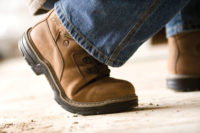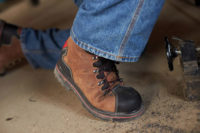
Safety hazards and job environment are first and foremost to consider when selecting work footwear. According to OSHA regulation 1910.136, every employer is required to conduct a hazard assessment to determine workplace risks and the appropriate types of personal protection equipment needed. OSHA also mandates that employers need to ensure that employees use protective footwear when working in areas where there is a danger of foot injuries.
Whether going online or heading to a local retail store, research brands and take an initial look at the products offered. Before you head to the store, remember to bring a pair of socks similar to those you would wear with workboots to get a true feel for the footwear and fit.
Technologies increase performance
Work in an environment that involves oil, water or other chemicals warrants footwear protection to help prevent slips or falls. A number of technologies exist to help create more assured footing and stability. For example, boots with a slip-resistant Vibram® rubber lug outsole provide resistance to oil, water, abrasion, chemical, heat and work-site slips.Safety-toe boots might be necessary when work environments pose risks for heavy objects crushing toes or exposed sharp objects potentially piercing the feet. Workers who are around electricity should consider boots with an advanced carbon fiber technology rather than a steel-toe boot. Many boot companies today incorporate carbon fiber technology into safety-toes as a lightweight option that is equally as protective as its steel counterparts, but up to 50 percent lighter.
Beat the elements
For warm weather on the worksite, select footwear that is breathable to keep feet cool.Outsoles with an aggressive treading are also desirable for safety footwear worn in wet and potentially slippery conditions. But because soles with an aggressive treading are sometimes heavier than the average boot, seek a lighter boot.
Do not underestimate cold weather when working outdoors in winter months. Boots with Thinsulate™ Insulation combat cold weather and keep feet comfortable.
Consider comfort
To maximize all-day comfort from the ground up, consider footwear that incorporates technically advanced comfort outsoles. Many outsoles exist with specific end-goals in mind, including added stability on multiple terrains and reduced shock absorption by the wearer. Choosing an appropriate outsole that performs and provides support is key in helping ensure that footwear is both safe and comfortable.Lightweight footwear might increase the comfort level for all-day wear. For a lighter boot, consider choosing footwear that features a Cordura® upper. Cordura is a high performance fabric resistant to abrasions, tears and scuffs that offers a reduced weight compared to a conventional leather boot.
Ease of transition
Buyers today have the option to choose a work boot closer to their own personal style that will allow them to transition from the workplace to the weekend seamlessly. Oxfords, chukkas, wellingtons, hiking and athletic styles now all feature the same benefits of a more traditional work boot.Wearing appropriate footwear on the worksite is one important precaution workers can take to help stay safe and comfortable on the job. Having an understanding of potential hazards in the workplace, comfort technology options and versatile styles allows you to choose the right boot without feeling overwhelmed. Consider these areas of importance in choosing a boot to not only help protect you from a potentially serious occupational injury, but also to equip you with a boot you will enjoy wearing.

